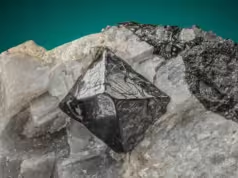Minerals
A mineral is a naturally occurring chemical compound usually of crystalline form and not produced by life processes. A mineral has one specific chemical composition, whereas a rock can be an aggregate of different minerals or mineraloids. The study of minerals is called mineralogy. To meet the definition of “mineral” used by most geologists, a substance must meet five requirements:
Quartz
Quartz is one of the most famous minerals on the earth. It occurs in essentially all mineral environments, and is the crucial constituent of many rocks. Quartz is likewise the maximum varied of all minerals, taking place in all distinct bureaucracy, habits, and colorings. There are more range names given to Quartz than any other mineral. Although the Feldspars as a group are more regular than Quartz, as an man or woman mineral Quartz is the maximum commonplace mineral.
Chlorite
Chlorite is the organization name for approximately 10 related minerals. However, the time period Chlorite may be used each to explain the organization in fashionable, or as a specific term to explain any inexperienced member of the Chlorite institution whose precise identity isn't always realistic to be decided.
Muscovite
Muscovite is the most common mineral of the mica own family. It is an essential rock-forming mineral present in igneous, metamorphic, and sedimentary rocks. Like other micas it with no trouble cleaves into skinny transparent sheets.
Biotite
Biotite is the most common mica mineral and also known as black mica, a silicate mineral in the common mica group. Approximate chemical formula K (Mg, Fe). Biotite can be found in massive crystal layers weighing several hundred pounds. It is abundant in metamorphic rocks (both regional and contact), pegmatites, and also in granites and other invasive magmatic rocks. Biotite usually occurs in brown to black, dark green variety.
Mica Group Minerals
Mica, any of a collection of hydrous potassium, aluminum silicate minerals. It is a kind of phyllosilicate, showing a -dimensional sheet or layer structure. Among the most important rock-forming minerals, micas are located in all 3 foremost rock types—igneous, sedimentary, and metamorphic.
Clay Minerals
Clay minerals are the function minerals of the earths close to floor environments. They shape in soils and sediments, and through diagenetic and hydrothermal alteration of rocks. Water is essential for clay mineral formation and most clay minerals are defined as hydrous alumino silicates.
Serpentine
Serpentine is not a single mineral instead a group of related minerals. Also for the primary contributors of Antigorite and Chrysotile, a difference is not commonly made between the character participants besides underneath medical study and type.
Amphibole
Amphibole is an crucial institution of usually darkish-colored, inosilicate minerals, forming prism or needlelike crystals,composed of double chain SiO 4 tetrahedra, connected at the vertices and normally containing ions of iron and/or magnesium in their systems.
Pyroxene
The pyroxenes are a set of essential rock-forming inosilicate minerals discovered in many igneous and metamorphic rocks. Pyroxenes have the general components is XY(Si,Al)2O6.Although aluminium substitutes extensively for silicon in silicates consisting of feldspars and amphiboles,
Epidote
Well developed crystals of epidote, Ca2Al2(Fe3+;Al)(SiO4)(Si2O7)O(OH), crystallizing inside the monoclinic system, are of frequent prevalence: they're normally prismatic in dependancy, the course of elongation being perpendicular to the single plane of symmetry.
Topaz
Topaz is a silicate mineral of aluminium and fluorine with the chemical formula Al2SiO4(F, OH)2. Topaz crystallizes in the orthorhombic system, and its crystals are mostly prismatic terminated by pyramidal and other faces.
Kyanite
Kyanite is commonly found in aluminum-rich metamorphic pegmatites and / or sedimentary rocks and is commonly a blue silicate mineral. Cyanide in metamorphic rocks show better pressures than four kilobars. Although it is undoubtedly strong at stress and low temperature, it is generally sufficiently high under these conditions where water hobbyist, muscovite, pyrophyllite or kaolinite-containing aqueous aluminosilicates are replaced. Kyanite is also called disten, ranetite and cyanide.











































